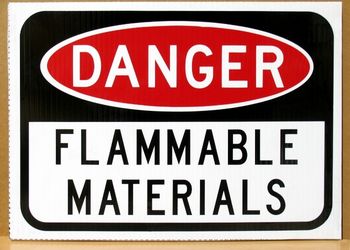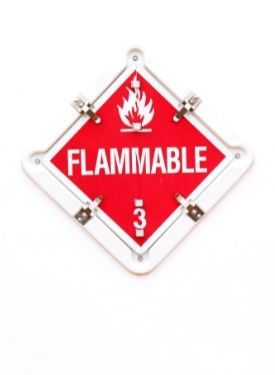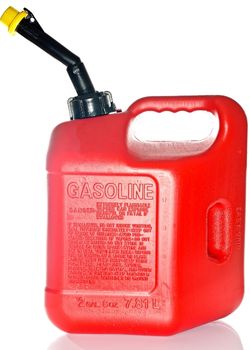Using the word flammable in place of combustible and vice-versa may seem like one of those “po-tay-toe, po-tah-toe” situations, but I’d beg to differ. Applying these terms interchangeably can cause you to treat flammable materials the same way you do combustible ones, and that’d be a big mistake. So what’s the difference?

Flammable and combustible materials are separated by their differences in boiling point and flashpoint. The boiling point of a combustible liquid is always over 100 degrees Fahrenheit while a flammable liquid has a boiling point under 100 degrees.
If you’re still a little confused, that’s okay. By the time you’re done reading, you’ll be a lot clearer on what both flammable and combustible materials mean directly from a firefighter.
Table of Contents
Flammable vs. Combustible According to the NFPA
The National Fire Protection Association or NFPA has its own system for categorizing flammable and combustible materials and OSHA has another.
For now, I want to talk about the NFPA’s system, which is known as the NFPA 30, the Flammable and Combustible Liquids Code.
According to that code, a liquid can be categorized into one of six classes depending on its boiling point.
Before I get into the organization of NFPA 30 classes, I should talk about what a boiling point means, as it’s going to be discussed in this article a lot.
A liquid’s boiling point refers to the temperature at which the liquid begins to boil. It then becomes a vapor.
Now that I got that out of the way, let’s examine the NPFA 30 code for flammable versus combustible liquids.
Class IA
The lowest class of liquids per the NFPA 30 is Class IA. These liquids have a boiling point under 100 degrees, which is approximately 37.8 degrees Celsius. Class IA liquids are considered flammable rather than combustible.
Class IB
Above Class IA is Class IB. The boiling point of liquid in this class is just at 100 degrees F or 37.8 degrees C. The boiling point may in some instances rise above that degree threshold, but Class IB liquids would still be considered flammable at that boiling point.
Class IC
Class IC liquids are the third and final flammable liquid categorization. Since flammable materials are usually not higher than 100 degrees, the boiling point of a Class IC liquid is 73 degrees F and 22 degrees C.
Class II
Moving on to Class II liquids, the boiling point of these liquids is 100 degrees F and 37.8 degrees C. This is the first class of combustible rather than flammable liquids due to the boiling point temperature.
Class III A
The second combustible liquids class is Class III A. The boiling point of these liquids far exceeds 100 degrees. The average boiling point of Class III A liquid is 140 degrees F and 60 degrees C. That’s quite hot!
Class III B
The most combustible liquids are those in the Class III B categorization. Their boiling point is 100 full degrees over the standard threshold. That’s right, the boiling point of a Class III B liquid is 200 degrees F and 93 degrees C.
Flammable vs. Combustible According to OSHA
Okay, now I want to discuss OSHA’s system, as you’ll recall that it differs quite significantly from the NFPA’s categorization of flammable versus combustible liquids. Since 2015, OSHA has followed a Globally Harmonized System or GHS to classify its liquids.
This overwrote the rules featured in OSHA standard 29 CFR 1910.106.
Rather than use six classes as the NFPA does, OSHA divides flammable and combustible liquids into one of four categories.

The reason for this is that OSHA focuses on both a liquid’s boiling point and its flashpoint. Before I get into the data then, let me explain what a flashpoint is.
All volatile materials have a flashpoint. It refers to the lowest possible temperature that vapor can be exposed to and still ignite. Thus, a flashpoint will be lower than a boiling point.
Keeping that in mind, let’s take a closer look at OSHA’s flammable and combustible liquids categorization.
Category 1
All liquids in OSHA’s Category 1 have a boiling point of 95 degrees F and 35 degrees C at the highest. The boiling point can be lower than these temperatures in Category 1 but never higher.
Category 2
Once the boiling point of a liquid exceeds 95 degrees F and 35 degrees C, the liquid officially enters Category 2 of OSHA’s classification system.
Category 3
A Category 3 liquid is one with a higher boiling point range. On the lower end, the boiling point may be 73 degrees F and 23 degrees C. At its highest, the boiling point is 100 degrees F and 37.8 degrees C. This is sort of like how in the NFPA’s flammable and combustible liquids categorization system, Class IC boiling point temps were lower than Class IB.
Category 4
The fourth and final category in OSHA’s system is Category 4. This is where liquids are classed when the boiling point clearly exceeds 100 degrees. Like Category 3, the Category 4 boiling points are presented as a temperature range.
On the lower end of that range is a boiling point of 140 degrees F and 60 degrees C. On the higher end are temperatures of 199.4 degrees F and 93 degrees C.
Flammable Liquid Examples
Between those two charts, you should have a clearer understanding of flammable versus combustible liquids. If you’re still feeling a little fuzzy though, this section and the next will be full of examples so you can clearly differentiate one type of liquid from the other.
Let’s start with examples of flammable liquids.
Mineral Spirits
You might have a canister of mineral spirits in your garage right now, especially if you’re thinning paint to repaint a room in your home. As a type of solvent, mineral spirits are categorized as flammable.
Hydrazine
Hydrazine is admittedly not one of those things the average person comes across all that often. A toxic organic compound, hydrazine is used in rocket fuel to burn when combined with oxygen.
Turpentine
Now here’s a more common product, turpentine. Produced from the extract of coniferous trees, turpentine is an oil that often goes into cosmetics, soap, cleaning agents, perfumes, and paint solvent.
Hexane
Speaking of cleaning agents, hexane is a primary ingredient used to make them. The oils extracted from vegetables and seeds go into the production of hexane, which is also a solvent. People aren’t supposed to breathe it in, as, in large quantities, it can affect your central nervous system.

Gasoline
That’s right, the gasoline your car might have in its tank right now is classified as a flammable material.
Ethyl Acetate
Like hexane, ethyl acetate is a popular ingredient in cleaning products and mixtures. You’ll also find it in perfume, lacquer, varnish, and some paints. You might want to rethink where you store products containing ethyl acetate given that it’s flammable.
Acetone
To remove varnish, paint, and even nail polish, you use acetone. Commonly found in medicine cabinets and garage cabinets alike, acetone seems like a perfectly innocent ingredient, but it too could start a fire.
Pentane
Behind the walls of your home is insulation. If the insulation uses polystyrene foam, such as around heating pipes and in your fridge, then pentane went into its production. That’s not good considering that pentane is flammable.
Combustible Liquid Examples
Combustible liquids are fewer and further between than flammable liquids, but there are still plenty out there. Allow me to tell you which they are.
Linseed Oil
Flax oil or linseed oil is a yellow-colored edible oil sourced from flax plants. The oil, despite its edibility, goes into applications such as stains, varnishes, and paints as well as concrete and wood preservative.
Kerosene
Gas is flammable and kerosene is combustible. That’s a good distinction to keep in mind if you have a generator or a heater that runs on kerosene.
Diesel
Diesel is not only flammable but combustible as well. That makes it doubly troublesome to have a diesel vehicle around a source of fire. The vehicle will surely go up in flames sooner than later!
Dichlorobenzene
Everyone hates pests around the house, but beware. The products you use to repel insects, bats, squirrels, mice, rats, and snakes could contain dichlorobenzene. This volatile organic compound is also combustible.
Tips for Storing Flammable and/or Combustible Liquids
If you have one or more of the above flammable and/or combustible materials in your home or on your property, I recommend following these storage tips.
Keep the Containers Closed Until Needed
Until you’re ready to open the canister of gas or turpentine and use the flammable or combustible liquid you purchased, keep the canister closed. When you use the liquid, be sure to secure the lid of the canister tightly every time.
Maintain a Dry, Cool Storage Area
Where you store flammable and combustible liquids matters a lot if you want to avoid explosion or fire. The canisters should always be stored in a dry, cool area. A cabinet, even a medicine cabinet, suffices, but a shed isn’t the best spot.
Avoid Ignition Sources
Any potential sources of ignition in the room around the flammable or combustible materials must be removed. That includes machinery, furnaces, fireboxes, boilers, electric lamps, hot plates, torches, ovens, and driers. Do not smoke cigarettes in a room holding combustible and/or flammable materials.
Flammable and combustible materials are not the same. Differences in boiling point and flashpoint separate liquids that are deemed more flammable than combustible or vice-versa. In some instances, a liquid can be both flammable and combustible.
That doesn’t mean you cannot keep flammable and/or combustible materials in your home or on your property, as you can. You just need to follow basic safety tips to prevent a fire. Be safe out there!